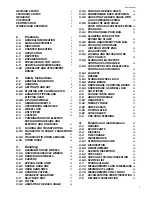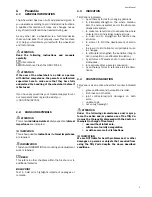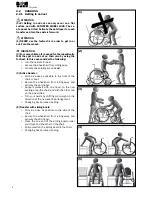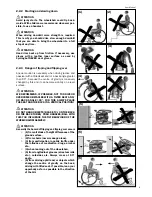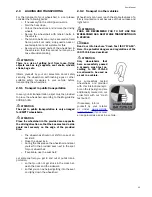
User Manual
9
(5)
(5)
(3)
(3)
(1)
(2)
(4)
(4)
2.2.2 Starting and slowing down
ATTENTION
Avoid jerky starts. The wheelchair could tip back-
wards. With children we recommend, whenever pos-
sible, to use a headrest.
ATTENTION
When driving downhill more strength is required.
This is why you should drive slow enough downhill
that you are able to bring the wheelchair to a full
stop at any time.
ATTENTION
Hand rims heat up from friction. If necessary, use
gloves with a leather inner surface as used by
cycling but NEVER wool gloves.
2.2.3 Danger of tipping and flipping over
Special caution is necessary when driving (active and
passive) with a tiltied seat and/or a back angle greater
than 90°, because the centre of gravity is massively
changed by this and it can become wobbily on a level
surface.
ATTENTION
WE RECOMMEND, IF POSSIBLE, NOT TO DRIVE OR
OVERCOME OBSTACLES WITH A TILTED SEAT AND/
OR BACK ANGLE >90°. FOR THIS ALWAYS PLACE
THE SEAT AND THE BACK IN A VERTICAL POSITION!
ATTENTION
DO NOT HANG OBJECTS (BAGS ETC.) ON THE BACK
OR THE BACK TUBES/ PUSH HANDLES/BAIL. WITH
THIS YOU INFLUENCE THE TILT BEHAVIOUR OF THE
WHEELCHAIR MASSIVELY.
ATTENTION
Generally the hazard of flipping and tipping over occurs
• (1) from all kinds of height differences of the
ground surface,
• (2) from chairs (never manage alone),
• (3) from participation in public traffic under
the influence of medication, drugs, alcohol
etc.,
• (4) when leaning out of the wheelchair,
• (5) from longitudinal grooves (streetcar rails
etc.), curbsides etc. Always cross at 90°
angle,
• (6) from driving uphill and/or objects which
change the centre of gravity on the back,
driving with tilted seat. If possible, lean your
upperbody as far as possible in the direction
of the hill.
(4)
(4)
(6)



